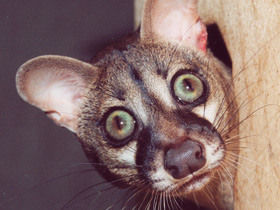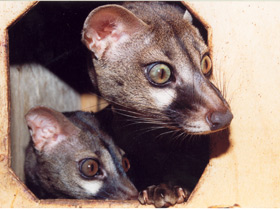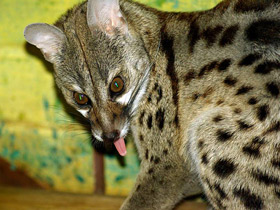Genet (the genus Genetta)
A genet (pronounced /ˈdʒɛnɪt/ or /dʒəˈnɛt/) is a member of the genus Genetta, which consists of 17 species of small African carnivorans. The common genet is the only genet present in Europe and occurs in the Iberian Peninsula, Italy and France.
Genet fossils from the Late Miocene and later have been found at sites in Ethiopia, Kenya and Morocco.
Characteristics
Genets are slender cat-like animals with a long body, a long ringed tail, large ears, a pointed muzzle and partly retractile claws. Their fur is spotted, but melanistic genets have also been recorded. They have musk glands and anal sacs. They also have perineal glands.
All genet species have a dark stripe along the spine; they differ in fur color and spot pattern. Their size varies between species from 40.9 to 60 cm (16.1 to 23.6 in) in head-to-body length with 40 to 47 cm (16 to 19 in) long tails; their tails are almost as long as head and body. They have large eyes with elliptical pupils; the iris is about the color of the fur. They can move their eyes within their sockets to a limited extent, and move their heads to focus on moving objects. Their pinnae have a fine layer of hair inside and outside. They can move the pinnae by about 80° from pointing forward to the side, and also from an erect position to pointing downwards. Their rhinarium is important for both sensing smell and touch.
Habitat
All genet species are indigenous to Africa. The common genet was introduced to southwestern Europe during historical times. It was brought from the Maghreb to Spain as a semi-domestic animal about 1000 to 1500 years ago, and from there spread to southern France and Italy. In Africa, it inhabits wooded habitats north of the Sahara, in savanna zones south of the Sahara to southern Africa and along the coast of Arabia, Yemen and Oman.
The Cape genet is endemic to fynbos, grassland and coastal forests in South Africa.
The South African small-spotted genet lives in woodland savanna, grassland, thickets, dry vlei areas in Angola, Namibia, South Africa and Zambia.
The rusty-spotted genet is widely distributed in sub-Saharan woodland savannah, savannah-forest mosaic, rain forest and montane forest up to an elevation of 3,400 m (11,200 ft) in Ethiopia.
The pardine genet lives in primary and secondary rainforests, gallery forests, moist woodlands, but also in plantations and suburban areas ranging from Senegal to the Volta River in Ghana.
The Abyssinian genet has been recorded in montane dry forest up to 3,750 m (12,300 ft) in Ethiopia.
The King genet is restricted to rainforest in the Congo Basin, Bioko Island, Ghana and Liberia.
The servaline genet lives in Central African lowland forests to high-altitude bamboo forest and coral rag thicket on Zanzibar.
The Angolan genet inhabits open miombo forest from Angola to central Tanzania.
The giant forest genet lives in rainforests of the Democratic Republic of the Congo and western Uganda.
The Hausa genet inhabits savannah and moist woodlands in West Africa.
G. letabae has been recorded in woodland savannah in Lesotho, Eswatini, Mozambique, Namibia and South Africa.
Johnston's genet inhabits dense rainforest in Upper Guinea.
The aquatic genet inhabits rainforests between the Congo River and the Rift Valley.
The crested servaline genet is endemic to Nigeria and Cameroon, where it inhabits scrub and primary deciduous forests.
Schouteden's genet inhabits rainforest, woodland savannah and savannah-forest mosaic in tropical Africa.
Bourlon's genet lives only in the Upper Guinean rainforests in West Africa.
Nutrition and lifestyle
Genetta feed on small animals, birds and their eggs, as well as invertebrates; sometimes this predator is detrimental to poultry. Fruit is an important part of the diet of all Genetta species, and the common Genetta is not averse to stealing someone's garden or house and leaving a pile of droppings on the roof of the house in return. In West Africa, the forest genet frequently raids roosts at dusk. During the day, the Genetta sleeps in a tree or in a den among rocks, curled up and covered by its long tail.
Reproduction and behaviour
They breed throughout the year, and their young are born after 10-12 weeks of gestation in a nest lined with dry grass. They usually have 1 to 4 cubs in a brood, which the mother feeds with milk until they are 6 months old. They remain on their mother's territory until about one year of age, but do not reach sexual maturity until two years of age.
Genets are easily domesticated; in Africa they are sometimes kept in the home to exterminate rats and mice. For a brief period in early medieval Europe, genettas were companion animals, but cats were quickly supplanted as pets.
Species
The following species have been described:
- Genetta abyssinica - Ethiopian Genet;
- Genetta angolensis - Angolan Genet;
- Genetta bourloni - Bourlon's Genet;
- Genetta cristata - Crested Genet (considered by some scientists as a subspecies of Genetta servalina);
- Genetta felina - Feline Genet (considered by some scientists as a subspecies of Genetta genetta);
- Genetta genetta - Common Genet;
- Genetta johnstoni - Johnston's Genet;
- Genetta maculata - Spotted Genet;
- Genetta pardina - Pardine Genet;
- Genetta piscivora - Aquatic or Fisher Genet (some consider it to belong to its own genus named Osbornictis);
- Genetta poensis - King Genet;
- Genetta servalina - Servaline Genet;
- Genetta thierryi - Haussa Genet;
- Genetta tigrina - Tigrine Genet;
- Genetta victoriae - Giant or Giant Forest Genet.
Extinct species:
- †Genetta nyakitongwer – Early Pleistocene of Kenya;
- †Genetta plesictoides – Late Pleistocene of Cyprus.
Genetta and Poiana are estimated to have diverged about 9.5 to 13.3 million years ago. Genetta species are estimated to have diverged at least 8.5 million years ago starting with the Hausa genet, followed by the giant genet 3.98 to 6.01 million years ago.
Threats
Loss of habitat due to deforestation and conversion of land to agriculture is a major threat for the crested servaline genet and Johnston's genet. Both genet species are also hunted for meat and skins. They are listed as Vulnerable on the IUCN Red Lists. These are also major threats for Bourlon's genet, which is classified as Near Threatened.
The aquatic genet may be affected by hunting, but major threats have not yet been identified. It is listed as Near Threatened on the IUCN Red List.
The king genet and the Abyssinian genet are so poorly known that threats cannot be identified. Both are listed as Data Deficient on the IUCN Red Lists.
The remaining genet species are not considered threatened and are listed as Least Concern on the IUCN Red Lists.
Etymology
The etymological origin of the word 'genet' is uncertain; it may be a derivation of the Arabic name djarnet. The English word comes from Old French 'genete', which came from Spanish 'gineta'.
As pets
Pet genets are mostly common genets, rusty-spotted genets or Cape genets.
The common genet (Genetta genetta)
The common genet (Genetta genetta) is a small viverrid indigenous to Africa that was introduced to southwestern Europe. It is widely distributed north of the Sahara, in savanna zones south of the Sahara to southern Africa and along the coast of Arabia, Yemen and Oman. It is listed as Least Concern on the IUCN Red List.
Appearance
Genetta genetta is a species of carnivorous mammal of the family Viveridae, the only one of this family that can be found in Europe.
The body length of an adult Genetta genetta genetta ranges between 42 and 58 cm, its tail measures between 39 and 53 cm and its weight does not exceed 2.5 kg. Its coat is greyish brown with black spots in horizontal rows. The tail of the Genetta genetta is relatively long and fluffy, with black transverse stripes; it has a tapering snout, short legs, large ears and short, retractable claws. This member of the family Viverridae emits a strong musky odour.
Habitat
Genetta genetta is widely distributed in Africa and, in some places, in western Asia. In ancient times, it was introduced into Europe in the Iberian Peninsula and southern France. Genets inhabit almost all environments where they can find suitable food. They mainly prefer forests and thickets near water. They can also be found in fields, on stony cliffs, on plains (in tall grass), in mountains (both treeless and wooded) up to 1400-3000 metres altitude. Can sometimes be found near villages and farmland. Avoid rainforests and arid areas.
Life style
Genets are fast and agile nocturnal animals. They run fast, jump far (up to 2 metres in length) and are excellent tree climbers. Genetta genetta are able to crawl along thorny branches, crawl between rocks and swim. They are very cautious and shy animals; they are difficult to detect both during the day, when they rest in hiding, and at night. Daytime hiding places can be rock crevices, burrows of diurnal animals, hollow trees and similar places. The animals hunt after sunset. The startled Genetta genetta raises its fur and releases a musky-smelling liquid. The secret anal glands are mainly used by females to mark their territory.
Nutrition and reproduction
These shy animals are active at night and solitary; they are rarely seen in mating groups. They sleep in their hiding places during the day and come out to hunt at night. They feed mainly on rodents, birds, reptiles, fish, carrion and eggs; they also occasionally eat insects and berries. Genetta genetta hunt exclusively on the ground. During the hunt, they silently approach their prey by stretching their tail and body in a single line, jumping sharply, grabbing the prey by the neck and strangling it, then quickly eating it.
The gestation period of the Genetta genetta is ten to twelve weeks. The female gives birth to two to four naked and blind cubs. At one year of age, they leave their mother.
Threats
No major threats to common genets are known. In North Africa and some localities in southern Africa, they are hunted for their fur. In Portugal, they get killed in predator traps. On Ibiza, urbanization and development of infrastructure cause loss and fragmentation of habitat.
Conservation
Genetta genetta is listed on Appendix III of the Bern Convention and in Annex V of the Habitats and Species Directive of the European Union.
Taxonomy
Viverra genetta was the scientific name proposed by Carl Linnaeus in 1758.
More than 30 subspecies of the common genet have been described. The following are considered valid:
- Genetta genetta genetta (Linnaeus), 1758 – Spain, Portugal and France;
- Genetta genetta afra (Cuvier), 1825 – North Africa;
- Genetta genetta senegalensis (Fischer), 1829 – sub-Saharan Africa;
- Genetta genetta dongolana (Hemprich and Ehrenberg), 1832 – Arabia.
Genetta felina has been reclassified as a species based on morphological diagnoses comparing 5500 Viverrinae specimens in zoological collections.
Along with other viverrids, genets are among living carnivorans considered to be the morphologically closest to the extinct common ancestor of the whole order.


















































